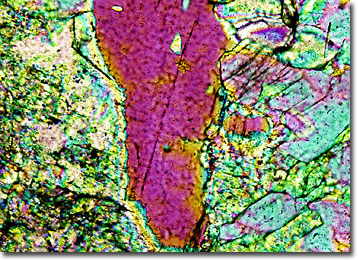Polarized Light Microscopy Digital Image Gallery
Orbicular Diorite
Diorite is a plutonic rock with a granular texture that is sometimes alternatively known as black granite. Comprised chiefly of plagioclase feldspar and small amounts of hornblende, biotite, and other dark-colored minerals, the rock exhibits a characteristic appearance usually described as “salt and pepper.”

Though diorite may occur independently, it is often associated with granite and gabbro intrusions, with which it sometimes merges. The rock is generally produced in the continental crust above subduction zones and is found in some forms worldwide. However, orbicular diorite is an extremely rare variety of the rock that contains many spherical lumps, or orbs, that exhibit concentric zones of light and dark color. Once only known on the island of Corsica, occurrences of orbicular diorite have now been found in South Africa, North Carolina, and a few other locales as well. Yet, how this unusual type of diorite forms has yet to be determined with certainty and is a matter of significant debate among geologists.
Diorite varies somewhat in overall color depending on the percentage of dark minerals it contains, but is often dark gray to black. The rock, which also frequently exhibits a dull green tint, is sometimes utilized as a building material and as an ornamental stone. However, current demand for diorite is relatively low, perhaps because of its dark coloration. The rock seems to have been more popular in antiquity when many artists used the readily polishable material to create beautiful sculptures, many of which have survived to modern times and can be viewed at museums around the world.
